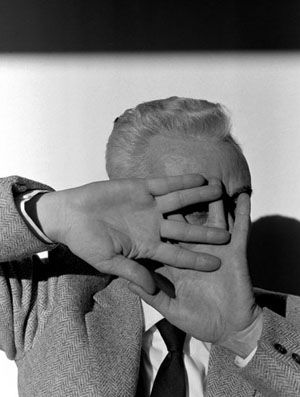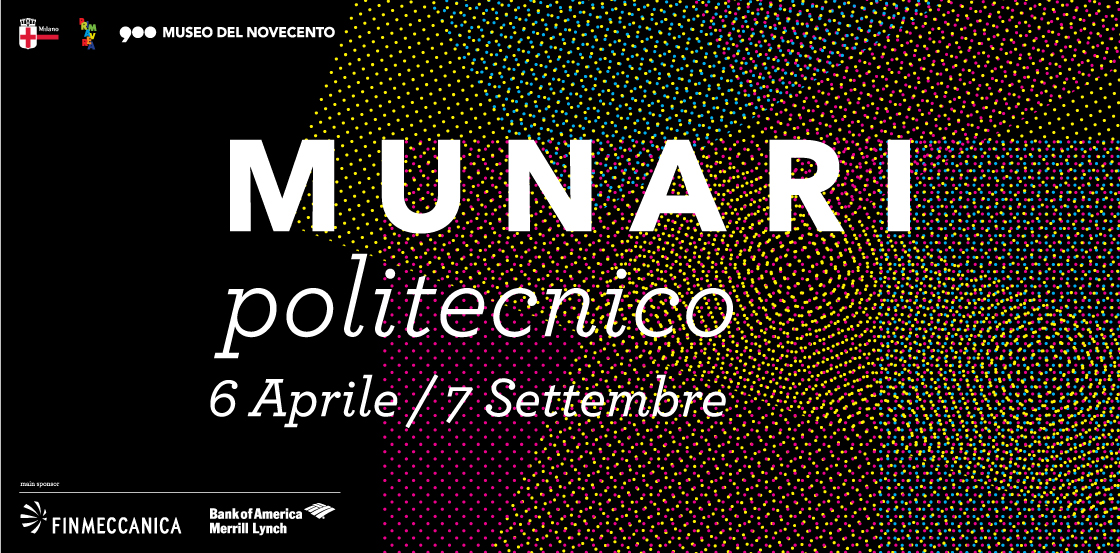FOCUS: “AND THAT WAS THAT. Bruno Munari, Ada Ardessi and Atto”
Museo del Novecento, Milan, April 6 – July 31, 2014
Curated by Marco Sammicheli with Giovanni Rubino. Graphic design and installation by Paolo Giacomazzi
 Bruno Munari used art as the original form of expression. Even before graphics, design, pedagogy and publishing, it was art that guided his creative genius. The exhibition Munari polytechnic is the story of a multifaceted creator, his role in Italian and European art in the course of the twentieth century and the connections that led him to become an eclectic protagonist of many artistic movements. The works in the exhibition come largely from the collection of Bruno Danese and Jacqueline Vodoz, who in their alternating roles as friends, collectors, publishers and entrepreneurs, supported and encouraged Munari to experiment with languages for decades, often acting as accomplices in important encounters and “trespassings”. The exhibition creates a dialogue between the works of Munari and those belonging to the Civic Collections of the City of Milan, the Museum of The Twentieth Century and the archives of the ISISUF (International Institute of Studies on Futurism) of which Munari, along with Carlo Belloli, was one of the founders.
Bruno Munari used art as the original form of expression. Even before graphics, design, pedagogy and publishing, it was art that guided his creative genius. The exhibition Munari polytechnic is the story of a multifaceted creator, his role in Italian and European art in the course of the twentieth century and the connections that led him to become an eclectic protagonist of many artistic movements. The works in the exhibition come largely from the collection of Bruno Danese and Jacqueline Vodoz, who in their alternating roles as friends, collectors, publishers and entrepreneurs, supported and encouraged Munari to experiment with languages for decades, often acting as accomplices in important encounters and “trespassings”. The exhibition creates a dialogue between the works of Munari and those belonging to the Civic Collections of the City of Milan, the Museum of The Twentieth Century and the archives of the ISISUF (International Institute of Studies on Futurism) of which Munari, along with Carlo Belloli, was one of the founders.
The goal of Munari polytechnic is to reveal his artistic inclination, a task that seems to be the continuation of the exhibition held in 1996 at the Vodoz-Danese Foundation of Milan, re-reading the collection and initiating a dialogue with a generation of artists who had a dialectical relationship with him.
The first four sections of the exhibition are devoted respectively to: the earliest artistic orientations of Munari as seen through drawing, collage and a visual approach related to historical avant-garde practices; his relation to scientific research as an aid to insights into plastic relationships, linguistic responses and as an activating element of creative functions; art as a generator of new disciplines; to the production of art during the succession of different twentieth century movements. These works come alive thanks to correspondences and influences, and are referred to in books by Munari as well as those by Mary Vieira and Victor Vasarely, and also because they were realized by authors who exhibited and shared research with him like Enzo Mari, Max Bill, Franco Grignani and Max Huber and because they are related to artists he frequented such as Getulio Alviani, Arturo Bonfanti, Paolo Scheggi and Marina Apollonio. Also to be highlighted are those who shared original moments with him, first of all Gillo Dorfles and Carlo Belloli, and later, the Gruppo T. Finally, this section includes artists who maintained an ideal relationship with Munari in terms of capacity and inspiration, such as Giulio Paolini and Davide Mosconi.
 The works of the selected artists discuss, interact and relate, then as now, with the aesthetic imagination of Munari, thanks also to the installation assembled with lightweight structures and different media, which remain connected thanks to gravity and interlocking pieces, all with an eye to Munari’s poetics, but also to the culture of contemporary design.
The works of the selected artists discuss, interact and relate, then as now, with the aesthetic imagination of Munari, thanks also to the installation assembled with lightweight structures and different media, which remain connected thanks to gravity and interlocking pieces, all with an eye to Munari’s poetics, but also to the culture of contemporary design.
Alongside the main exhibition, the Focus is dedicated to the photographic work, partly unpublished, of Ada Ardessi and Atto, authors who for decades worked closely with Munari and witnessed the main events in the life of the man and artist. The exhibition is titled “Chi s’è visto s’è visto (And that is that)”, a phrase that Munari loved to quote in order to subvert knowingly the relationship between self-representation, the visual dimension of portraits and their apparent reflections. This expression was often reinterpreted during long periods of collaboration and in special moments of friendship, as much with Ada Ardessi as with Atto, who for more than forty years have documented the most important stages of his creative path. The photographs on exhibit render the elusive semantic complexity of Munari and give contrary evidence to the didactic label he was branded with over the years.
The show does not have a catalogue, but while it is under way, the curator will gather testimonies, interviews and essays from those who met or worked with Munari, presenting also the work of scholars who have focused on this quintessential figure of the twentieth century. The publication of this material is scheduled to be released at the conclusion of the exhibition and aims to add a living and dialectic testimony to our image of Munari, artist and anti-specialist.







